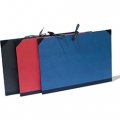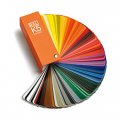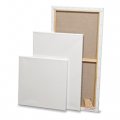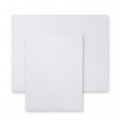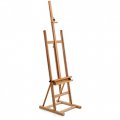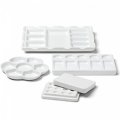Stretched Canvases & Screens
Information on stretcher frames and canvases
Painting on canvas-covered wooden frames developed in the late Middle Ages and gradually replaced the traditional use of solid wooden panels. The low weight of the fabric-covered wooden construction proved its worth especially with large image formats. The covering originally consisted of linen fabric, more precisely the flax of the linen plant, which then gave its name to the canvas.
The stretcher frame
A modern stretcher frame consists of four wooden strips whose ends are slotted and tapped so that they can be joined together at an angle of 90°. The special thing about this is that the corner connection is neither fixed with glue nor with nails. The stability of the frame is only achieved by stretching and fixing the screen. Should the canvas lose tension over time, the frame is wedged out, i.e. eight wooden wedges are driven from the inside into the corners so that the outer dimension of the frame and thus the tension of the painting cloth increases.
The purpose of wedging is not to correct an unsuccessful, too slack covering, but to compensate for changes in tension due to changes in humidity and temperature. This is often only necessary after years. Too much wedging causes cracks, because once the primer and paint have dried, they can no longer follow the movement of the canvas when wedging. Wedge frames covered with unprimed canvas should be wedged out at the earliest after priming, because natural fabrics such as linen or cotton contract when they become damp. When covering a stretcher frame with unprimed fabric, it should first be stretched slightly looser so that the stretcher frame does not warp when the fabric shrinks.
The Canvas
Two of the main materials that are suitable as canvas fabrics are linen and cotton. As an image carrier, linen is particularly characterised by its tensile strength and stability. It is therefore particularly suitable for larger stretcher frame formats or as a base for heavy layers of paint. Cotton is much cheaper than linen, but shrinks more and is not quite as tear-resistant. Thin, fine cotton fabric is more suitable for small image formats and care should be taken when priming, as it is possible for the primer to penetrate to the back of the fabric.
The ideal weave for canvas fabrics is the linen weave, in which a weft thread crosses a warp thread to produce a regular cross pattern. This fabric warps evenly when it absorbs moisture during priming. In comparison, a fabric in diagonally woven twill weave is much more difficult to weave and warps more in one direction when primed.
Covering the stretcher frame
Covering a stretcher frame initially requires some practice. The cut (unprimed or already primed) cloth is placed under the frame so that the warp and weft threads of the fabric run parallel to the edges of the frame. Tensioning is then usually carried out from the centre of the slats towards the edges, always in such a way that after one point has been fixed, the same point is fixed to the opposite slat under tension of the fabric. A collet facilitates the pulling of the fabric. Small upholstered nails with flat heads, but also tacker clips, which are shot in with a hand or electric tacker, are suitable for attaching the painting cloth.
If the stretcher frame is covered with unprimed canvas, it must be primed with Gesso before painting. A good primer ensures that the porous, highly absorbent and paint-swallowing substrate is made impermeable and solidified. Particularly in oil painting, the primer prevents the binding agent oil from being removed from the paint and drawn into the substrate. With less binder, the oil paint dries wrinkly and easily cracks.
First aid for warped frames
In rare cases, fluctuations in air humidity can lead to distortion of the wedge frame strips. To avoid this, care should be taken not to expose covered stretcher frames to very high or very low humidity for long periods of time. A stretcher frame that is slightly warped by the tensile forces of the canvas fabric after very tight stretching can usually be corrected by slight counter-pressing.
First aid when the canvas has become limp
If a screen has lost its tension, the first step should be to moisten the back of the screen. This causes the tissue to contract and the tension to return. Only if the picture is very limp for a longer time and throws dents, the wedges in the corners can be struck lightly or the canvas can be tightened at the appropriate places by loosening the fixings and fixing them again. A screen often loses its tension even in winter when the heating air is dry. The problem usually solves itself in spring, when the air humidity contracts the canvas fabric again.
